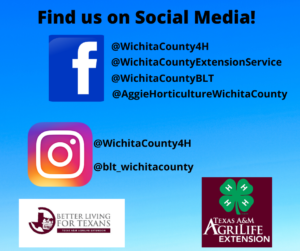Connect with us:
 Join us on Facebook or Instagram!
Join us on Facebook or Instagram!
Texas 4-H: https://texas4-h.tamu.edu/
4-H empowers young people to be true leaders. True leaders are young people who have confidence; know how to work well with others; can endure through challenges; and will stick with a job until it gets done. In 4-H, we believe true leaders aren’t born – they’re grown.
Getting involved with 4-H is easy and costs are kept to a minimum. Unlike other youth organizations, 4-H doesn’t require a uniform and there are no national fees. Children select their 4-H education project so they can choose one that works well within a family’s budget. 4-H programs and clubs typically meet once per week or once per month, although some may choose to meet more or less frequently. 4-H programs are available for children ages 8-18.
4-H Clover bud programs are available for children ages 5-7.
Please call Katrena Mitchell at the Wichita County Extension Office for more information about the Wichita County 4-H Program, 940-716-8610 or email: katrena.mitchell@ag.tamu.edu
Interested in learning about 4-H? Read below about our history then click over to the other pages and find out how to get involved!
4-H is a community of young people across America who are learning leadership, citizenship and life skills. 4-H is about having fun, learning, exploring and discovering. In 4-H, young people make new friends, develop new skills, become leaders and help shape their communities.
4-H gives them a chance to pursue their own interests – from photography to computers, from building rockets to raising animals. A list of 4-H projects is available here. They go places – to camp, to state and national conferences. They learn to be leaders and active citizens. In 4-H clubs, they serve as officers and learn to conduct meetings, handle club funds, and facilitate group decision-making. They give back to their communities. 4-H members get involved in volunteer projects to protect the environment, mentor younger children and help people who are less fortunate.

The History of the 4-H Clover and Emblem
The first 4-H emblem was a three-leaf clover, introduced sometime between 1907 and 1908. The three “H’s” represented head, heart and
hands. In 1911, at a meeting of club leaders in
Washington, a fourth “H” representing health was added and the current 4-H four-leaf clover emblem was approved. It is protected by the U.S. Congress. More information on Clover logo usage is available.
The 4-H pledge was worded by Otis Hall, Kansas state 4-H leader. It was approved at the first National 4-H Club Camp in 1927 in Washington, D.C. The words “my world” were added to the pledge in 1973. Their addition is the only change ever made to the 4-H pledge.
HEAD stands for clearer thinking and decision-making. Knowledge that is useful throughout life.
HEART stands for greater loyalty, strong personal values, positive self-concept, concern for others.
HANDS stands for larger service, workforce preparedness, useful skills, science and technology literacy.
HEALTH stands for better living, healthy lifestyles.

